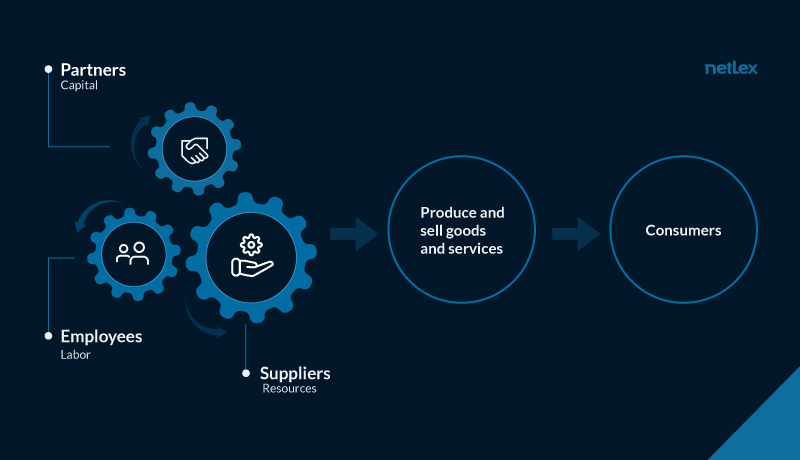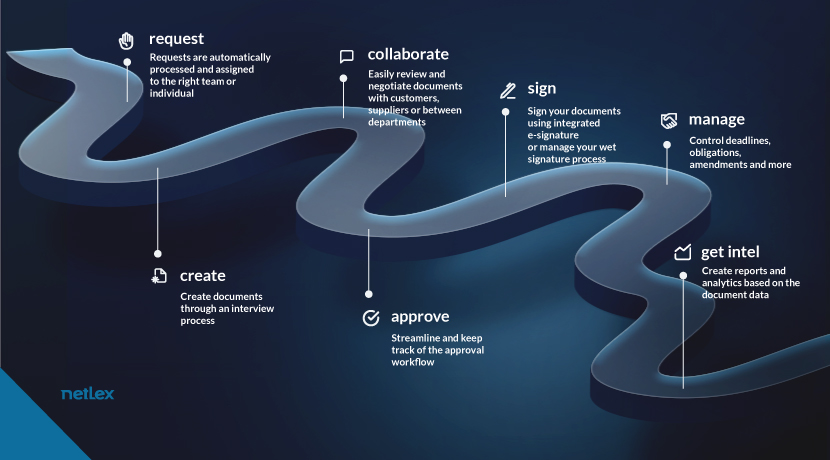A company is essentially an organization created to produce and/or sell goods and services.
However, even with the obvious differences between the local foodshop and the Fortune 500 Enterprises, it is possible to understand that all companies follow a similar logic.
The better this logic works, the better will be the chances of success.

The main parts of this gear are the partners, workers, suppliers and consumers. And what connects each of those gears to another? Contracts.
They constitute the society, register agreements, create rights and obligations, give incentive (or disincentive) to certain actions. The contracts also determine what the company has sold, when and to whom it must deliver, which price is to be paid, who has representational powers on which cases and so on. They coordinate the relationship between all parts of the gear.
However, a contract’s lifecycle can be complex - a condition that tends to worsen as the company grows.
When the contract’s management practices are not ideal, the enterprise is subjected to:
- Organizational inefficiency;
- Elevated expenditure, as the teams need to dedicate more time to manual tasks Losses provoked by reduced compliance with contractual obligations;
- Losses following from missed deadlines, penalties and other adverse consequences.
The result is very concrete: according to a research conducted by the World Commerce and Contracting, up to 9% of a company's total income might be lost due to bad contract management.
To solve these problems, a concept has been drawing considerable attention all over the world: Contract Lifecycle Management - CLM, a solution that is progressively becoming essential to the effective management of these documents.
In this article you will get to know a little more about CLM, and to find out how technology may positively impact the performance of your organization.
What is Contract Lifecycle Management?
Contract Lifecycle Management - CLM, is a set of management practices that allow the increase of efficiency in the administration of all processes involving contracts within a company. In adopting this set of practices, the corporation minimizes the risk of suffering setbacks on various fronts.
With the addition of technology through the so called CLM softwares - such as netLex -, these practices will be able to optimize all steps in the management of a contract’s lifecycle, stimulating automation and simplification of procedures, ensuring their perfect execution.
The steps of a well adjusted CLM
We consider that a good Contract Lifecycle Management includes, at least, seven steps: Request, Creation, Negotiation, Revision and Approval, Signature, Execution management and Intelligence.

At netLex, we believe that, in order to reduce the user’s workload and to generate intelligence, we must allow the full cycle to be conducted within the platform, even if each company has their own specific workflows with third parties. That empowers us to automate routines, collect data automatically and to reuse this data throughout the workflow.
See below an explanation of each step of this flow and some corresponding functionalities of netLex:
Request
Every contract is born out of a demand. An effective contract management ensures that the flow of these requests is directed and standardized, allowing for greater simplicity and security. The procedure may also signalize some upfront important elements, such as execution deadlines.
Beyond that, netLex also allows:
- Flexible questionnaire process;
- Automatic routing of the request to those responsible;
- Deadline control (SLA), with a dashboard for viewing the request’s progress.
Creation
After a successful request, it is time to effectively create the contract. CLM can establish a predefined flow of document creation, in a space designed to make this phase more efficient, which includes the definition of templates. That helps, for example, to save time and reduce mistakes.
To maximize this stage’s results, with netLex it is possible to:
- Create files in an automated way, using company templates and data provided by the Request or through integration with other softwares;
- Automatically extract metadata;
- Send a document through a specific workflow, observing contractual terms.
Negotiation
A delicate phase, the negotiation must be conducted with guaranteed registry, security and access to all involved parties. When integrated with CLM, the technology provides considerable gains to the negotiation, especially with regards to agility and compliance.
See how netLex can help you in this matter:
- Negotiation portal, with included chat and controlled external access;
- Negotiation via collaborative real-time editor with simultaneous editing or via questionnaire;
- Automatic version control;
- Alterations’ approval restricted to authorized users.
Revision and Approval
CLM solutions have also provided important progress to the revision and approval stages of an agreement.
Previously, these steps were mostly carried out via email, which resulted in the risk of losing or neglecting versions, amongst other problems. It is important to count on technology so that this phase runs smoothly and safely. With netLex, it is possible to:
- Establish automatic variations in the approval hierarchy, depending upon the contractual terms;
- Determine revision and approval workflows with SLA control;
- Conduct conversations in the internal chat;
- Approve the final version in a simplified way, with email alerts.
Signature
Key moment in the operation, when all that was decided will finally be confirmed and go into effect, the signature was also a sensitive point for those involved in contract management.
“How will we sign?”, “Can it be digital?”, “How to ensure the document arrives to all involved?” were only a few of the questions to be answered.
The moment of signing the contract becomes smoother with netLex due to features such as:
- Native integration with leading digital and electronic signature providers;
- Automatic recognition of document’s status as signed;
- No need to download or upload documents;
- Full control over the entire procedure within netLex.
Execution management
As important as (or even more important than) concluding a good deal is to ensure that the terms agreed to are fulfilled, and this is only possible if the contract’s management is properly conducted.
Companies who wish to conduct good contract management must be attentive to document storage, ensuring that it is in an easily accessible location protected within information security parameters.
Get to know some of netlex’s features for this stage of the operation:
- Automatic metadata extraction, which allows to improve management of contractual terms (e.g. parties, price, obligations etc.);
- Automatic alerts that can be customized based on the document’s metadata, allowing for a more accurate tracking;
- Intelligent Repository, with search and categorization by metadata;
- Easy access to all negotiation history;
Intelligence
Nowadays, companies that can accurately analyze data relating to their business gain a major competitive advantage in the market.
Contracts are a great source of operational intel and, when well administered may integrate the Business Intelligence strategy, assisting in the promotion of a more assertive decision making process in various levels.
Understand some of the contributions netLex can provide to users in this stage:
- Allows for the creation of graphs and reports based on the document’s or workflow’s metadata;
- Facilitates the export of data and documents to other systems via API.
CLM’s benefits to contract management
In short, among the benefits of the management of contracts through CLM are:
- Defining the workflow, improving routine flow;
- Task simplification. CLM assists in the reduction of complexity, with a clearer and more intuitive workflow;
- Streamlining the relationship between the legal team and the supplies department, along with the other agents involved in negotiations;
- Improves compliance;
- Effective management of KPI’s (Key Performance Indicators);
- Assists in the reduction of direct losses, such as the non-execution of a payment clause, as well as collateral damage, such as labor lawsuits;
- Streamlining negotiating and closing deals;
- Greater focus on strategic demands.
CLM: greater efficiency for your company
As exposed, contracts are the foundation and the body of all companies, regardless of their size.
It is through these documents that the organizations establish relationships and that are registered the terms and conditions that will define the directions to the future. Therefore, it is extremely important to carry out a good management of these assets.
By adopting netLex as a technological solution to their CLM strategy, clients have observed an increase of efficiency of up to 214% in document creation, with a 50% reduction in contract negotiation time.
To better understand how we can help your journey, click here to talk to one of our consultants!






